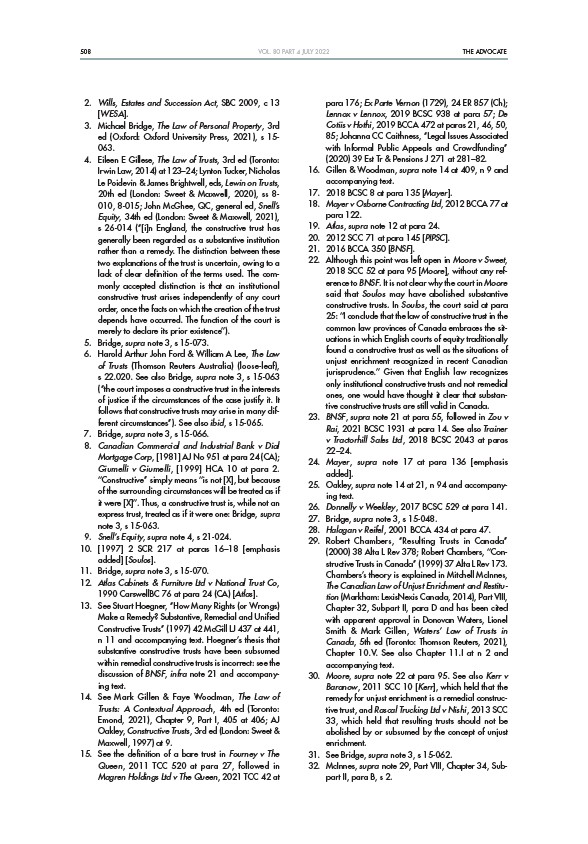
508 THE ADVOCATE
VOL. 80 PART 4 JULY 2022
2. Wills, Estates and Succession Act, SBC 2009, c 13
WESA.
3. Michael Bridge, The Law of Personal Property, 3rd
ed (Oxford: Oxford University Press, 2021), s 15-
063.
4. Eileen E Gillese, The Law of Trusts, 3rd ed (Toronto:
Irwin Law, 2014) at 123–24; Lynton Tucker, Nicholas
Le Poidevin & James Brightwell, eds, Lewin on Trusts,
20th ed (London: Sweet & Maxwell, 2020), ss 8-
010, 8-015; John McGhee, QC, general ed, Snell’s
Equity, 34th ed (London: Sweet & Maxwell, 2021),
s 26-014 (“in England, the constructive trust has
generally been regarded as a substantive institution
rather than a remedy. The distinction between these
two explanations of the trust is uncertain, owing to a
lack of clear definition of the terms used. The commonly
accepted distinction is that an institutional
constructive trust arises independently of any court
order, once the facts on which the creation of the trust
depends have occurred. The function of the court is
merely to declare its prior existence”).
5. Bridge, supra note 3, s 15-073.
6. Harold Arthur John Ford & William A Lee, The Law
of Trusts (Thomson Reuters Australia) (loose-leaf),
s 22.020. See also Bridge, supra note 3, s 15-063
(“the court imposes a constructive trust in the interests
of justice if the circumstances of the case justify it. It
follows that constructive trusts may arise in many different
circumstances”). See also ibid, s 15-065.
7. Bridge, supra note 3, s 15-066.
8. Canadian Commercial and Industrial Bank v Dial
Mortgage Corp, 1981 AJ No 951 at para 24 (CA);
Giumelli v Giumelli, 1999 HCA 10 at para 2.
“Constructive” simply means “is not X, but because
of the surrounding circumstances will be treated as if
it were X”. Thus, a constructive trust is, while not an
express trust, treated as if it were one: Bridge, supra
note 3, s 15-063.
9. Snell’s Equity, supra note 4, s 21-024.
10. 1997 2 SCR 217 at paras 16–18 emphasis
added Soulos.
11. Bridge, supra note 3, s 15-070.
12. Atlas Cabinets & Furniture Ltd v National Trust Co,
1990 CarswellBC 76 at para 24 (CA) Atlas.
13. See Stuart Hoegner, “How Many Rights (or Wrongs)
Make a Remedy? Substantive, Remedial and Unified
Constructive Trusts” (1997) 42 McGill LJ 437 at 441,
n 11 and accompanying text. Hoegner’s thesis that
substantive constructive trusts have been subsumed
within remedial constructive trusts is incorrect: see the
discussion of BNSF, infra note 21 and accompanying
text.
14. See Mark Gillen & Faye Woodman, The Law of
Trusts: A Contextual Approach, 4th ed (Toronto:
Emond, 2021), Chapter 9, Part I, 405 at 406; AJ
Oakley, Constructive Trusts, 3rd ed (London: Sweet &
Maxwell, 1997) at 9.
15. See the definition of a bare trust in Fourney v The
Queen, 2011 TCC 520 at para 27, followed in
Magren Holdings Ltd v The Queen, 2021 TCC 42 at
para 176; Ex Parte Vernon (1729), 24 ER 857 (Ch);
Lennox v Lennox, 2019 BCSC 938 at para 57; De
Cotiis v Hothi, 2019 BCCA 472 at paras 21, 46, 50,
85; Johanna CC Caithness, “Legal Issues Associated
with Informal Public Appeals and Crowdfunding”
(2020) 39 Est Tr & Pensions J 271 at 281–82.
16. Gillen & Woodman, supra note 14 at 409, n 9 and
accompanying text.
17. 2018 BCSC 8 at para 135 Mayer.
18. Mayer v Osborne Contracting Ltd, 2012 BCCA 77 at
para 122.
19. Atlas, supra note 12 at para 24.
20. 2012 SCC 71 at para 145 PIPSC.
21. 2016 BCCA 350 BNSF.
22. Although this point was left open in Moore v Sweet,
2018 SCC 52 at para 95 Moore, without any reference
to BNSF. It is not clear why the court in Moore
said that Soulos may have abolished substantive
constructive trusts. In Soulos, the court said at para
25: “I conclude that the law of constructive trust in the
common law provinces of Canada embraces the situations
in which English courts of equity traditionally
found a constructive trust as well as the situations of
unjust enrichment recognized in recent Canadian
jurisprudence.” Given that English law recognizes
only institutional constructive trusts and not remedial
ones, one would have thought it clear that substantive
constructive trusts are still valid in Canada.
23. BNSF, supra note 21 at para 55, followed in Zou v
Rai, 2021 BCSC 1931 at para 14. See also Trainer
v Tractorhill Sales Ltd, 2018 BCSC 2043 at paras
22–24.
24. Mayer, supra note 17 at para 136 emphasis
added.
25. Oakley, supra note 14 at 21, n 94 and accompanying
text.
26. Donnelly v Weekley, 2017 BCSC 529 at para 141.
27. Bridge, supra note 3, s 15-048.
28. Halagan v Reifel, 2001 BCCA 434 at para 47.
29. Robert Chambers, “Resulting Trusts in Canada”
(2000) 38 Alta L Rev 378; Robert Chambers, “Constructive
Trusts in Canada” (1999) 37 Alta L Rev 173.
Chambers’s theory is explained in Mitchell McInnes,
The Canadian Law of Unjust Enrichment and Restitution
(Markham: LexisNexis Canada, 2014), Part VIII,
Chapter 32, Subpart II, para D and has been cited
with apparent approval in Donovan Waters, Lionel
Smith & Mark Gillen, Waters’ Law of Trusts in
Canada, 5th ed (Toronto: Thomson Reuters, 2021),
Chapter 10.V. See also Chapter 11.I at n 2 and
accompanying text.
30. Moore, supra note 22 at para 95. See also Kerr v
Baranow, 2011 SCC 10 Kerr, which held that the
remedy for unjust enrichment is a remedial constructive
trust, and Rascal Trucking Ltd v Nishi, 2013 SCC
33, which held that resulting trusts should not be
abolished by or subsumed by the concept of unjust
enrichment.
31. See Bridge, supra note 3, s 15-062.
32. McInnes, supra note 29, Part VIII, Chapter 34, Subpart
II, para B, s 2.